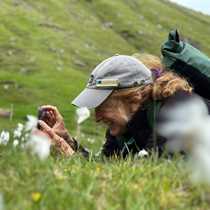Imagine walking along the shore of the Columbia River, an ongoing assortment of new flowers, trees, birds, reptiles, mammals and fish have surprised and delighted you for many months now. You stop to pick the diaphanous parachute from a milkweed seedpod clutching its precious seed cargo, and release it to the will of the winds. It wouldn’t be hard to imagine Meriwether Lewis tromping along the shore, stopping at the dried plant fragments and doing just that. Thomas Jefferson had chosen the leader for the Corps of Discovery well. With astute powers of observation, Meriwether Lewis did not disappoint Jefferson in his instructions which included observations of “…winds prevailing at different seasons, the dates at which particular plants put forth or lose their flowers, or leaf, times of appearance of particular birds, reptiles or insects…” The descriptions written by Lewis of new plants and animals numbered upwards of 500 to 1,000 words and sometimes more.
We started our travels up the Columbia River last night and found ourselves this morning at the John Day Dam. A tailwind pushed us up the Columbia as we continued upriver towards the McNary Dam. The winds fell calm for a short time while we made a stop at the McNary Wildlife Refuge. Here, we had the chance to walk and meet a few of the plants and birds Meriwether Lewis first described to western science nearly 200 years ago, including Sagebrush (Artemisia tridentata) and the Black-billed Magpie (Pica pica). We found a tree that had recently been felled by a beaver, as evidenced by the teeth marks left by the beaver’s ever-growing incisors. After our stroll we continued our way up the Columbia on the Sea Bird and during dinner turned onto the Snake River. By the end of dessert we were locking through Ice Harbor Dam.
While our descriptions of the sights we see may not be as wordy as the observations recorded by Captain Lewis, our experiences are no less memorable as we travel with the wind at our back, in the wake of Lewis and Clark.
We started our travels up the Columbia River last night and found ourselves this morning at the John Day Dam. A tailwind pushed us up the Columbia as we continued upriver towards the McNary Dam. The winds fell calm for a short time while we made a stop at the McNary Wildlife Refuge. Here, we had the chance to walk and meet a few of the plants and birds Meriwether Lewis first described to western science nearly 200 years ago, including Sagebrush (Artemisia tridentata) and the Black-billed Magpie (Pica pica). We found a tree that had recently been felled by a beaver, as evidenced by the teeth marks left by the beaver’s ever-growing incisors. After our stroll we continued our way up the Columbia on the Sea Bird and during dinner turned onto the Snake River. By the end of dessert we were locking through Ice Harbor Dam.
While our descriptions of the sights we see may not be as wordy as the observations recorded by Captain Lewis, our experiences are no less memorable as we travel with the wind at our back, in the wake of Lewis and Clark.




